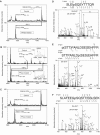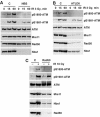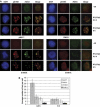Involvement of novel autophosphorylation sites in ATM activation
- PMID: 16858402
- PMCID: PMC1538573
- DOI: 10.1038/sj.emboj.7601231
Involvement of novel autophosphorylation sites in ATM activation
Abstract
ATM kinase plays a central role in signaling DNA double-strand breaks to cell cycle checkpoints and to the DNA repair machinery. Although the exact mechanism of ATM activation remains unknown, efficient activation requires the Mre11 complex, autophosphorylation on S1981 and the involvement of protein phosphatases and acetylases. We report here the identification of several additional phosphorylation sites on ATM in response to DNA damage, including autophosphorylation on pS367 and pS1893. ATM autophosphorylates all these sites in vitro in response to DNA damage. Antibodies against phosphoserine 1893 revealed rapid and persistent phosphorylation at this site after in vivo activation of ATM kinase by ionizing radiation, paralleling that observed for S1981 phosphorylation. Phosphorylation was dependent on functional ATM and on the Mre11 complex. All three autophosphorylation sites are physiologically important parts of the DNA damage response, as phosphorylation site mutants (S367A, S1893A and S1981A) were each defective in ATM signaling in vivo and each failed to correct radiosensitivity, genome instability and cell cycle checkpoint defects in ataxia-telangiectasia cells. We conclude that there are at least three functionally important radiation-induced autophosphorylation events in ATM.
Figures







Similar articles
-
Constitutive phosphorylation of ATM in lymphoblastoid cell lines from patients with ICF syndrome without downstream kinase activity.DNA Repair (Amst). 2006 Apr 8;5(4):432-43. doi: 10.1016/j.dnarep.2005.12.002. Epub 2006 Jan 19. DNA Repair (Amst). 2006. PMID: 16426903
-
Regulation of ATM in DNA double strand break repair accounts for the radiosensitivity in human cells exposed to high linear energy transfer ionizing radiation.Mutat Res. 2009 Nov 2;670(1-2):15-23. doi: 10.1016/j.mrfmmm.2009.06.016. Epub 2009 Jul 5. Mutat Res. 2009. PMID: 19583974
-
Extracellular signal-related kinase positively regulates ataxia telangiectasia mutated, homologous recombination repair, and the DNA damage response.Cancer Res. 2007 Feb 1;67(3):1046-53. doi: 10.1158/0008-5472.CAN-06-2371. Cancer Res. 2007. PMID: 17283137
-
ATM activation and DNA damage response.Cell Cycle. 2007 Apr 15;6(8):931-42. doi: 10.4161/cc.6.8.4180. Epub 2007 Apr 20. Cell Cycle. 2007. PMID: 17457059 Review.
-
The ATM-dependent DNA damage signaling pathway.Cold Spring Harb Symp Quant Biol. 2005;70:99-109. doi: 10.1101/sqb.2005.70.002. Cold Spring Harb Symp Quant Biol. 2005. PMID: 16869743 Review.
Cited by
-
Molecular and Functional Characterization of a Cohort of Spanish Patients with Ataxia-Telangiectasia.Neuromolecular Med. 2017 Mar;19(1):161-174. doi: 10.1007/s12017-016-8440-8. Epub 2016 Sep 23. Neuromolecular Med. 2017. PMID: 27664052
-
MUS81 Inhibition Enhances the Anticancer Efficacy of Talazoparib by Impairing ATR/CHK1 Signaling Pathway in Gastric Cancer.Front Oncol. 2022 Apr 11;12:844135. doi: 10.3389/fonc.2022.844135. eCollection 2022. Front Oncol. 2022. PMID: 35480096 Free PMC article.
-
ATM-dependent phosphorylation of MEF2D promotes neuronal survival after DNA damage.J Neurosci. 2014 Mar 26;34(13):4640-53. doi: 10.1523/JNEUROSCI.2510-12.2014. J Neurosci. 2014. PMID: 24672010 Free PMC article.
-
Human RAD50 deficiency in a Nijmegen breakage syndrome-like disorder.Am J Hum Genet. 2009 May;84(5):605-16. doi: 10.1016/j.ajhg.2009.04.010. Epub 2009 Apr 30. Am J Hum Genet. 2009. PMID: 19409520 Free PMC article.
-
Assessing BRCA1 activity in DNA damage repair using human induced pluripotent stem cells as an approach to assist classification of BRCA1 variants of uncertain significance.PLoS One. 2021 Dec 2;16(12):e0260852. doi: 10.1371/journal.pone.0260852. eCollection 2021. PLoS One. 2021. PMID: 34855882 Free PMC article.
References
-
- Andegeko Y, Moya L, Mittleman L, Tsarfaty I, Shiloh Y, Rotman G (2001) Nuclear retention of ATM at sites of DNA double strand breaks. J Biol Chem 276: 38224–38230 - PubMed
-
- Bakkenist CJ, Kastan MB (2003) DNA damage activates ATM through intermolecular autophosphorylation and dimer dissociation. Nature 421: 499–506 - PubMed
-
- Carney JP, Maser RS, Olivares H, Davis EM, Le Beau M, Yates JR III, Hays L, Morgan WF, Petrini JH (1998) The hMre11/hRad50 protein complex and Nijmegen breakage syndrome: linkage of double-strand break repair to the cellular DNA damage response. Cell 93: 477–486 - PubMed
Publication types
MeSH terms
Substances
LinkOut - more resources
Full Text Sources
Other Literature Sources
Molecular Biology Databases
Research Materials
Miscellaneous

